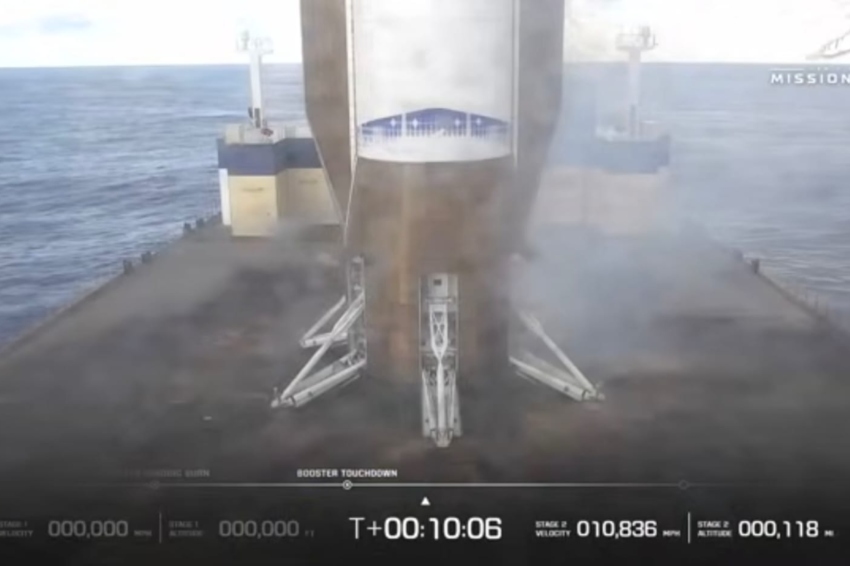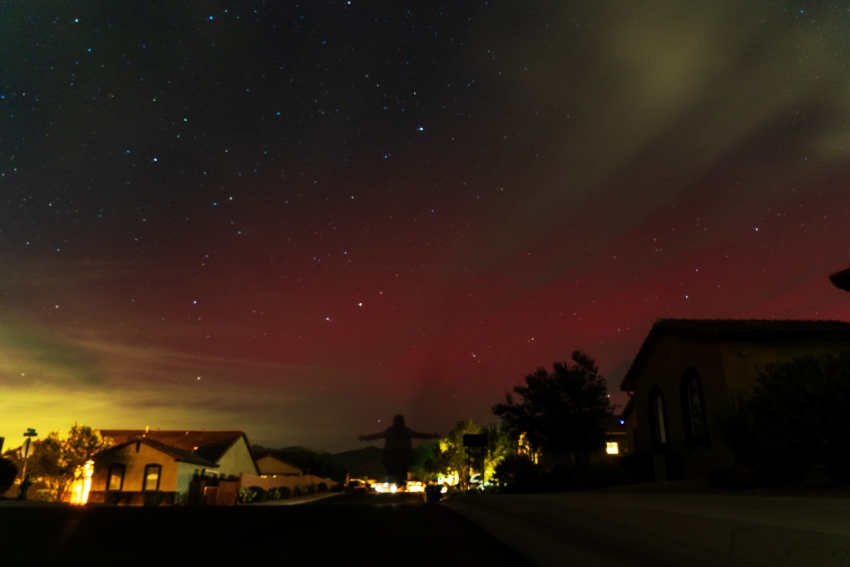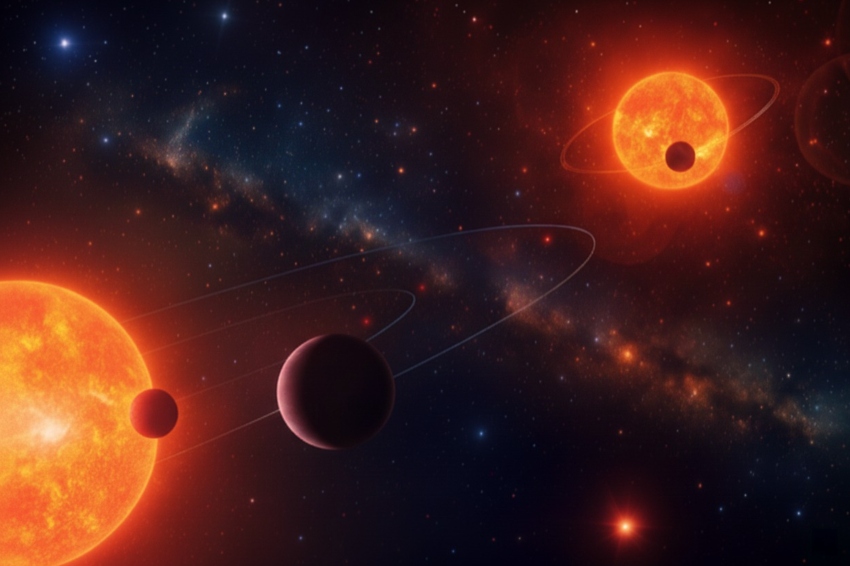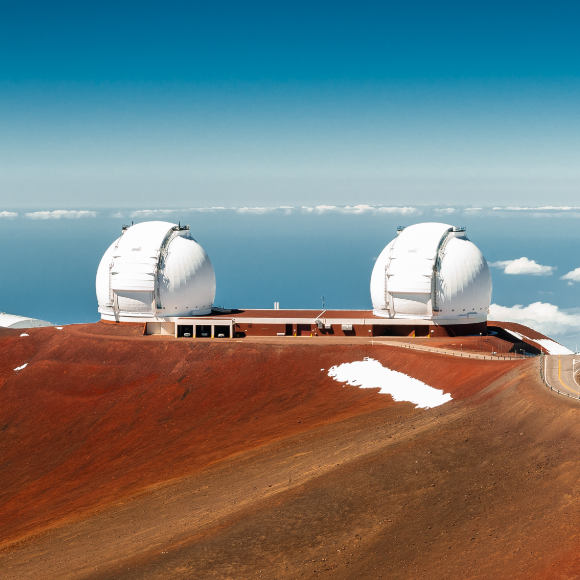Solar Storms and a Mars-Bound Launch: This Week in Space
Blue Origin successfully launched a mission to Mars — despite solar storms that lit up the aurora as far south as the U.S. Deep South. China sets new launch records, and astronomers uncover unusual planets in a distant star system. This Week in Space

15 November 2025
|

12 minutes
|
Successful Launch
Blue Origin successfully launched the ESCAPADE mission last Thursday evening, carrying twin NASA satellites designed to study the atmosphere of Mars. This marked the first operational flight of Blue Origin’s new heavy-lift rocket, New Glenn, which completed a successful experimental maiden flight earlier this year.
The launch was originally scheduled for an earlier date, but after lengthy deliberations, engineers scrubbed it at the last moment due to cloud cover over the Florida launch site. A new date was set for last Wednesday, only for the launch to be delayed again just hours before liftoff — this time because of strong solar storms. Ultimately, it was postponed to Thursday evening, and after several holds in the countdown, the rocket lifted off shortly before 3:00 p.m. EST
The mission proceeded without issues. Three minutes after liftoff, the second stage – carrying the satellites – separated from the first stage and continued toward Earth orbit. The first stage fell back through the atmosphere, stabilized itself with its engines exactly as planned, and touched down softly on the drone ship Jacqueline in the Atlantic Ocean. This was the first successful landing of a New Glenn booster, following an unsuccessful attempt during the rocket’s maiden flight.

The first stage of New Glenn moments after landing on the drone ship | Screenshot from Blue Origin’s broadcast
The twin satellites are intended to study the upper atmosphere of Mars, particularly its interaction with the solar wind. Researchers hope the mission’s data will help explain what happened to Mars’s atmosphere, which billions of years ago was thick and dense enough to allow liquid water on the surface, complete with rainfall cycles and clouds. At some point, most of that atmosphere evaporated into space, and today its density is only about 1.5 percent that of Earth’s. Another key goal of the mission is applied research to support future crewed missions to Mars by providing tools to forecast solar-storm effects so astronauts on the Martian surface can prepare for sharp increases in radiation levels and protect themselves accordingly.
Spacecraft bound for Mars are usually launched during “launch windows,” when the relative positions of Earth and Mars allow for a relatively short journey — typically between seven and eleven months. Such a window opens roughly every 26 months. This launch occurred outside the usual window due to numerous delays that prevented NASA from placing the satellites on New Glenn’s maiden flight as originally planned.
For this reason, their trajectory is different: the spacecraft will first travel to the Lagrange point L2, one of the locations where the gravitational forces of Earth and the Sun balance each other, allowing a spacecraft to remain there with very little fuel. As the next launch window opens about a year from now, they will fire their engines and enter a transfer trajectory that will carry them to Mars in September 2027, where they are expected to operate in orbit for about two years.
This route carries more risks than a direct flight to Mars: it requires more fuel, and the spacecraft will be exposed to radiation for a longer period, especially during times of heightened solar activity. On the other hand, NASA and Blue Origin hope that using this path will serve as a proof of concept for future crewed missions to Mars. Such missions will require launching dozens or even hundreds of rockets, carrying equipment that must arrive separately from the astronauts. Sending all that cargo within the narrow few-week Mars launch window could be extremely challenging, and a trajectory with an intermediate “parking stop” could allow some payloads to be launched months before the window opens.
A Successful Launch and Landing: Highlights from New Glenn’s First Operational Mission:
The Sun Is Going Wild
As noted, the launch scheduled for last Wednesday was postponed due to heightened solar activity. Although such activity does not endanger the launch itself, engineers were concerned that the resulting electrical and magnetic disturbances could damage the spacecraft.
The recent surge in solar activity has produced solar flares as well as coronal mass ejections (CMEs) — events in which an unusually large amount of charged particles is expelled from the Sun along with powerful magnetic fields. Under normal conditions, the charged particles released by the Sun — known as the solar wind — encounter Earth’s magnetic field, follow its field lines toward the poles, and form the Van Allen belts, the doughnut-shaped radiation zones surrounding our planet. Near the poles, these particles strike the upper atmosphere, ionizing gas molecules and producing the colorful light displays known as the aurora.
However, during particularly powerful solar eruptions like those seen in recent days, the aurora can be visible far from the polar regions. In the United States, for example, sightings of the northern lights were reported as far south as Alabama, Florida, and Arizona — states closer to the equator than to the North Pole — and even in Mexico. Alongside the spectacular views, powerful solar eruptions can also pose risks to satellites and spacecraft and, in extreme cases, disrupt electrical and communications infrastructure on Earth.

Bathed in green and red. The aurora as seen in the town of Marana in southern Arizona on Tuesday, November 11, 2025 | Photo: Jennifer G. Lang, Shutterstock
China’s Records and Setbacks
China broke its annual space-launch record last week, reaching 72 orbital launches so far in 2025 — surpassing the 68 launches it carried out in all of 2024.
On November 10, China launched three Shiyan-32 satellites into orbit aboard a Long March 11 rocket. China described these military satellites as “experimental” but released no details about their design or mission.
On November 11, a Long March 12 rocket launched nine additional satellites for the Guowang network — China’s planned broadband mega-constellation intended to compete with SpaceX’s Starlink. China aims to deploy 13,000 low-Earth-orbit satellites for this system. At present, the constellation comprises just over one hundred satellites of two models. Guowang is one of several Chinese government and private communications-satellite constellations being built in parallel for both civilian and military uses. Altogether, these networks are expected to exceed 50,000 active satellites once fully deployed.
The two other launches this week were carried out by private companies.
CAS Space launched two Earth-observation satellites on Saturday aboard a Kinetica-1 rocket. The following day, another private firm, Galactic Energy launched three satellites on its Ceres-1 rocket, which has been operational since 2020. The rocket’s first three stages performed nominally, but its fourth-stage engine shut down prematurely, preventing it from reaching orbital velocity. The stage and its payload subsequently fell back to Earth and crashed into the sea.
Despite China’s impressive pace, it still ranks second globally in total launches this year — behind the United States, or more precisely, behind SpaceX, which has conducted 143 of the 150 U.S. launches so far in 2025. More than one hundred of those were Falcon 9 launches deploying Starlink satellites. SpaceX is also on track to set a new annual launch record.
With more than six weeks remaining, 2025 is already the busiest year in history for orbital rocket launches worldwide.

A record-breaking year for China’s public and private space sectors alike. Launch of Earth-observation satellites on a Kinetica-1 rocket this week | Photo: CCTV
Coming Home in a Different Ship
Three Chinese astronauts who were delayed aboard China’s space station due to concerns about damage to their spacecraft returned safely to Earth last Friday morning — in the vehicle that had brought their replacement crew to the station.
The astronauts of the Shenzhou-20 mission — Chen Dong, Wang Jie, and Chen Zhongrui — were originally scheduled to come home two weeks ago after a six-month stay aboard the Tiangong space station. They completed several days of handover activities with the Shenzhou-21 crew, which arrived about three weeks ago, but their return was postponed after engineers suspected that a small piece of space debris had struck their spacecraft while it was docked.
China’s space agency reported this week that the astronauts were in good condition and continuing their routine work on the station. Eventually, mission managers decided they would return to Earth aboard the Shenzhou-21 spacecraft — the one that had delivered their replacements — and they landed safely in China last week.
Because of this swap, the crew currently aboard the Chinese space station now has no usable emergency escape vehicle. According to reports, the damage to the docked Shenzhou-20 capsule is a small crack in one of its windows, though the extent of the damage remains unclear. China may choose to accelerate the launch of the next spacecraft, Shenzhou-22, and send it to the station uncrewed — a move that could delay the next scheduled crew rotation.

For now, the crew appears to be managing comfortably — at least according to reports from China. The Shenzhou-20 and Shenzhou-21 crews during handover operations aboard the Tiangong space station | Photo: CMSA
Two By Two
Many stars in the Milky Way — and likely throughout the universe — are not solitary like our Sun but instead members of binary systems, in which two stars orbit one another. Now, an international team of researchers has, for the first time, identified two Earth-sized planets orbiting the stars in such a system.
The system, TOI-2267, consists of two red dwarf stars located about 190 light-years from Earth. The stars are separated by roughly eight astronomical units (about 1.2 billion kilometers) — slightly less than the distance between Saturn and the Sun.
The first detection of a planet in this system was reported several years ago, based on observations made by the TESS space telescope in 2019 and 2020. That planet is similar in size to Earth and orbits its host star every 3.5 Earth days. TESS is designed to identify planets in other solar systems by precisely measuring stellar brightness and searching for small, periodic dips caused when a planet passes between its star and the telescope.
The research team, led by Sebastián Zúñiga-Fernández of the University of Liège in Belgium, reprocessed TESS’s observations of TOI-2267 and found evidence for two additional planets, each also roughly Earth-sized and orbiting very close to their host star. One completes an orbit in 2.03 days, and the other in 2.28 days. However, the team notes that the detection of the latter remains uncertain and requires further confirmation.
TESS excels at identifying systems that may host planets, but its resolution is insufficient to reveal every detail. To strengthen their findings, the researchers compared the TESS data with ground-based observations from telescopes in Tenerife and Morocco, and also analyzed additional TESS follow-up observations. Their analysis indicates that if three planets do indeed exist in this system, they must be arranged so that two orbit one star and one orbits the other.
“Our discovery breaks several records, as it is the most compact and coldest pair of stars with planets known, and it is also the first in which planets have been recorded transiting around both components,” said Francisco J. Pozuelos of the Andalusian Institute of Astrophysics – Instituto de Astrofísica de Andalucía (IAA-CSIC) in Granada, Spain, co-lead of the study. “This system is a true natural laboratory for understanding how rocky planets can emerge and survive under extreme dynamical conditions, where we previously thought their stability would be compromised.”

The first known system of its kind, with Earth-sized planets orbiting both stars of a binary red-dwarf system. Artist’s impression of the TOI-2267 system | Illustration: © Mario Sucerquia (University of Grenoble Alpes)







